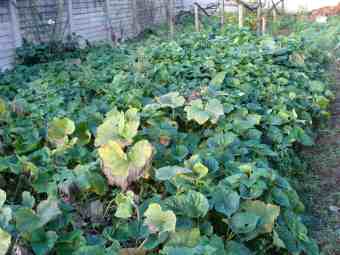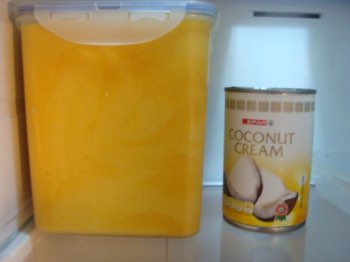- Bernard Preston homepage
- Yellows
- Supermarket Butternut Squash Soup Recipe
Supermarket butternut squash soup recipe
Supermarket butternut squash soup recipe reveals just what's in this very expensive junk-food.
How is it that the manufacturing industry can take delicious, nutritious food from a mixed-patch of butternut and sweet potato like this and turn it into such garbage?
They rely on our laziness to turn a profit; or is it just that we presume it's too difficult to make a delicious soup?
Or perhaps we think because we are working full-time, we can afford these little luxuries like a supermarket butternut squash soup recipe; but what if the malignancy that comes with it leaves you cash strapped?

This page was last updated by Dr Bernard Preston on 8th November, 2021.
Trying to combine a participation in the race to end waste, and finding more food for our worms and hens has taken me into some places that I would normally choose to avoid.
Our green grocer has provided us with some wonderful food for the beasties, but not enough, so we tried the supermarket. In a bag of trash we brought home, amongst the rotten fruit and vegetables, was a plastic packet of a supermarket butternut squash soup recipe.
At first I considered feeding it to our dogs, because they love our butternut, but the packet was bulging under pressure and was long past its sell by date. It went to the worms who are less concerned about such niceties.
And I thought to check the ingredients and was utterly shocked; equally sobering was the price.
I find it no surprise that we live in a world of metastatic illness and shocking autoimmune diseases like multiple sclerosis. Whilst there are many unknowns in poor health, much is very clear, and there's strong science to back it up; it is not just my opinion.
Supermarket butternut squash soup recipe
Supermarket butternut squash soup recipe should make you think twice before purchasing this junk food; it's also very expensive.
The contents list the following ingredients
- TBHQ - generally considered safe at these doses, but does cause stomach cancer.
- Colouring - why does such a beautifully coloured soup need extra orange?
- Emulsifiers - ours is perfectly smooth and doesn't separate out.
- Flavouring - I guarantee it doesn't taste as good as homemade butternut squash soup.
- Preservatives
- Imitation cream. Coconut cream is the real thing.
- Hydrogenated fat. Conclusively shown to be toxic.
- Stabilisers.
- Maltodextrin
- Sulphur dioxide.
- E631 and E627
- Total sodium 220mg / 100g
Package 500g. Out of stock currently; in fact I've been watching for it on the shelves for over a year and they haven't sold it again; can't say I'm surprised.
It's back in stock with a 600ml packet for R30.
Butternut with its deep orange colour is one of the richest sources of beta carotene, a very important phytochemical in our diets. Don't buy them in pill form; just enjoy the rich flavour of these foods. It's the precursor of vitamin A, a very important substance with many functions in the body.
You can read more about it at our roasted butternut squash recipe; use the search function in the navigation bar on your left.
In fact, let me add a word about that search function. This Bernard Preston and our sister site are very large with well over a thousand pages between them. Navigating your way around is difficult.
The site map helps but that search function is invaluable; it scans both.
The hue of that supermarket butternut soup is pale and insipid in comparison with our organic fruit that climbs all over the compost heaps; so much for their artificial colouring. Again, one has to ask why add such risky chemicals when nature does it so well?
I refuse to taste that soup laden with chemicals; alas in many cases that is exactly what you get when you eat out.
It takes about twenty minutes of preparation to peel the butternut and sweet potatoes, and ten minutes to pressure cook. Certainly in under three quarters of an hour you have three litres of rich homemade butternut soup that will supply you with dinner for a week; the supermarket price for 5 packets would be R150.
From the garden the cost is almost zero; a small amount for some cumin and ginger, and R20 for a can of coconut cream. In season, which is autumn, right now we are making 3 litres at a time, much of which we give away. That would cost R150 for the junk, compared to R25 for the highest quality butternut soup from your own kitchen or, using greengrocer ingredients, R35; a quarter of the price of your supermarket butternut squash soup recipe.
Most women work too hard in my opinion; they are expected to hold down a full time job, do the shopping, keep the home clean and tidy and bring up the kids. Something has to give, and usually it's her health.
Beta carotene
Beta carotene is a very common phytochemical, having an orangey red colour; perhaps its most important function comes from being a precursor of vitamin A. It's found in abundance in both homemade and supermarket butternut squash soup recipe.
Known often as provitamin A, it's the main dietary source of this very important vitamin. As always, it's better from your food than in supplements; in smokers that latter has a increased rate of lung cancer by the way.
Butternut and pumpkins in general, carrots, sweet potatoes and your greens are all rich sources of beta carotene. Deficiencies are unlikely unless you're a meat and potatoes man.
Vitamin A is vital in the eye where it binds to various proteins to form the rods and cones in the retina. A deficiency is the most common cause of blindness in children with an estimated half million cases every year.
Again there are dangers from too much vitamin A in supplements which causes birth defects.
Overdoses from supplements are also a cause of osteoporosis and bone fracture; oddly it inhibits bone formation, but stimulates osteolysis.
In short, as always, get your vitamins from your food; in this instance, plenty of butternut, carrots and your greens; then you need have no fear of deficiency or the dangers of overdosing from supplements.
It was the father of medicine, Hippocrates, who said let your food be your medicine.
Instead we have rather followed the dictates of the industry and allowed our food to become the cause of our early demise.

It took me twenty minutes of ingredient preparation, and the same again in the pressure cooker yesterday to make this real homemade easy butternut squash soup, with coconut cream; why would anyone want to buy the crappy, expensive stuff from the supermarket?
Bernard Preston
Bernard Preston is a semi-retired DC with a fascination for vibrant living; so many of us fall far short and unnecessarily have a life filled with pain and disability. Could it be that your food, like this crappy supermarket butternut soup recipe, could be the single most important reason for your loss of wellness?
Lack of exercise is the second. If you are gardener, in fact everyone because we sit too much, then you should be strengthening the lower back on a daily basis, just as you brush and hopefully floss your teeth.
A daily walk, particularly after a starchy meal, is another non-negotiable for those who want to reach their eighties and even nineties with all their marbles and joints intact. Blue Zone longevity is how it is being done if five unique areas of the world[1].
I don't like pain, so I do these exercises and keep busy too.
At our home we are trying to create what we call a Cyan Zone; combining the virtues of wellness from those five areas of the world, with caring for the planet. Striving to attain these blue and green issues in our latter days has been one of the most rewarding phases of our lives.

- Blue zones @ TED talks - in inspiring National Geographic voyage of discovery.
Newsletter
Our newsletter is entitled "create a cyan zone" at your home, preserving both yourself and Mother Earth for future generations; and the family too, of course. We promise not to spam you with daily emails promoting various products. You may get an occasional nudge to buy one of my books.
Here are the back issues.
- Lifestyle and ideal body weight
- What are ultra-processed foods?
- Investing in long-term health
- Diseases from plastic exposure
- Intensive lifestyle management for obesity has limited value
- A world largely devoid of Parkinson's Disease
- The impact of friendly bacteria in the tum on the prevention of cancer
- There's a hole in the bucket
- Everyone is talking about weight loss drugs
- Pull the sweet tooth
- If you suffer from heartburn plant a susu
- Refined maize meal and stunting
- Should agriculture and industry get priority for water and electricity?
- Nature is calling
- Mill your own flour
- Bake your own sourdough bread
- Microplastics from our water
- Alternative types of water storage
- Wear your clothes out
- Comfort foods
- Create a bee-friendly environment
- Go to bed slightly hungry
- Keep bees
- Blue zone folk are religious
- Reduce plastic waste
- Family is important
- What can go in compost?
- Grow broad beans for longevity
- Harvest and store sunshine
- Blue zone exercise
- Harvest and store your rainwater
- Create a cyan zone at your home
Did you find this page interesting? How about forwarding it to a friendly book or food junkie? Better still, a social media tick would help.
- Bernard Preston homepage
- Yellows
- Supermarket Butternut Squash Soup Recipe
Address:
56 Groenekloof Rd,
Hilton, KZN
South Africa
Website:
https://www.bernard-preston.com